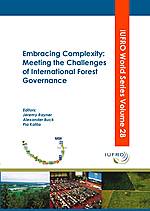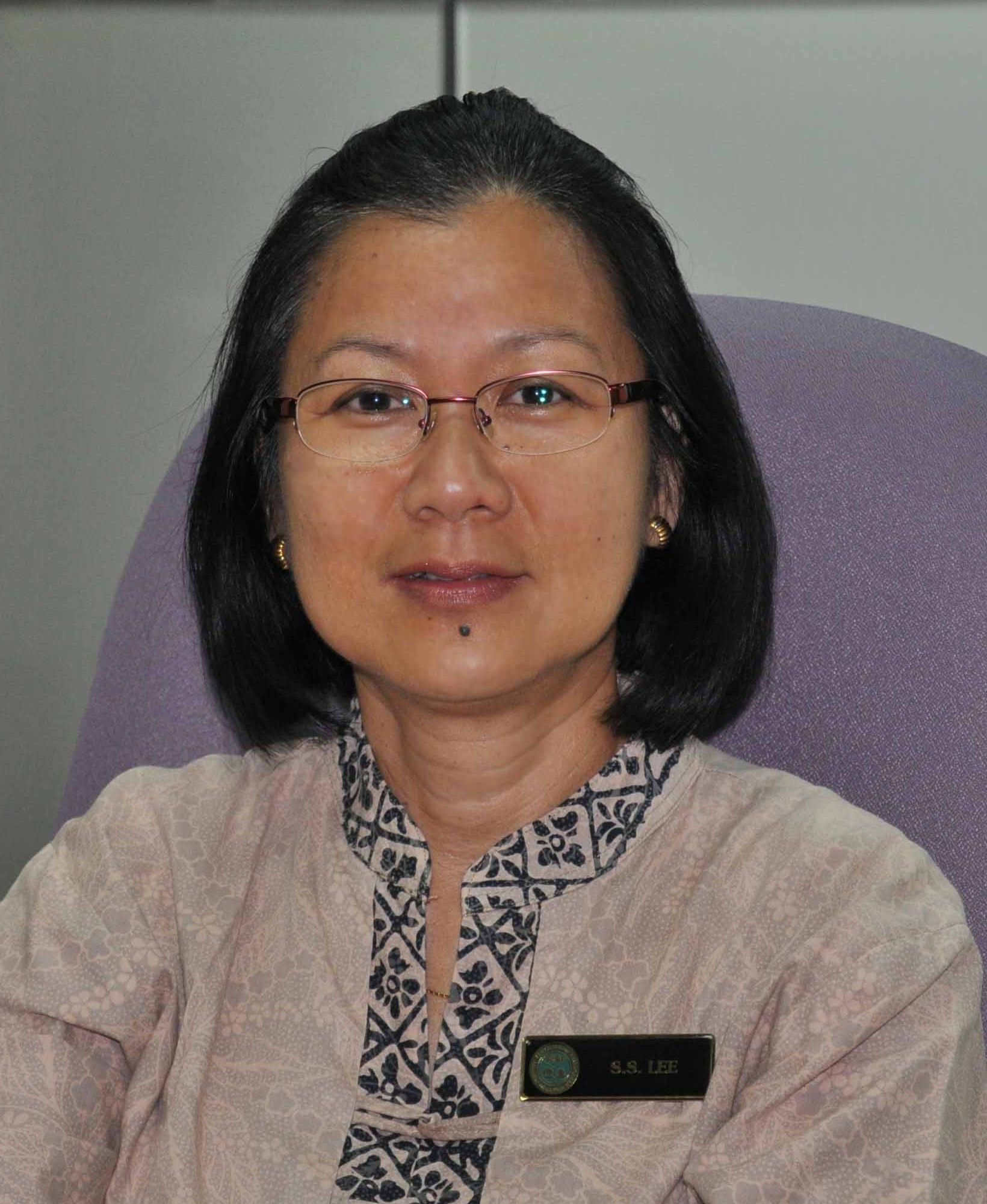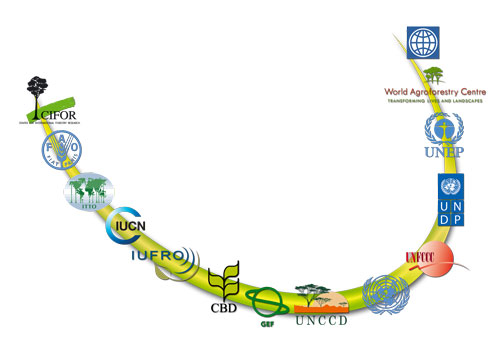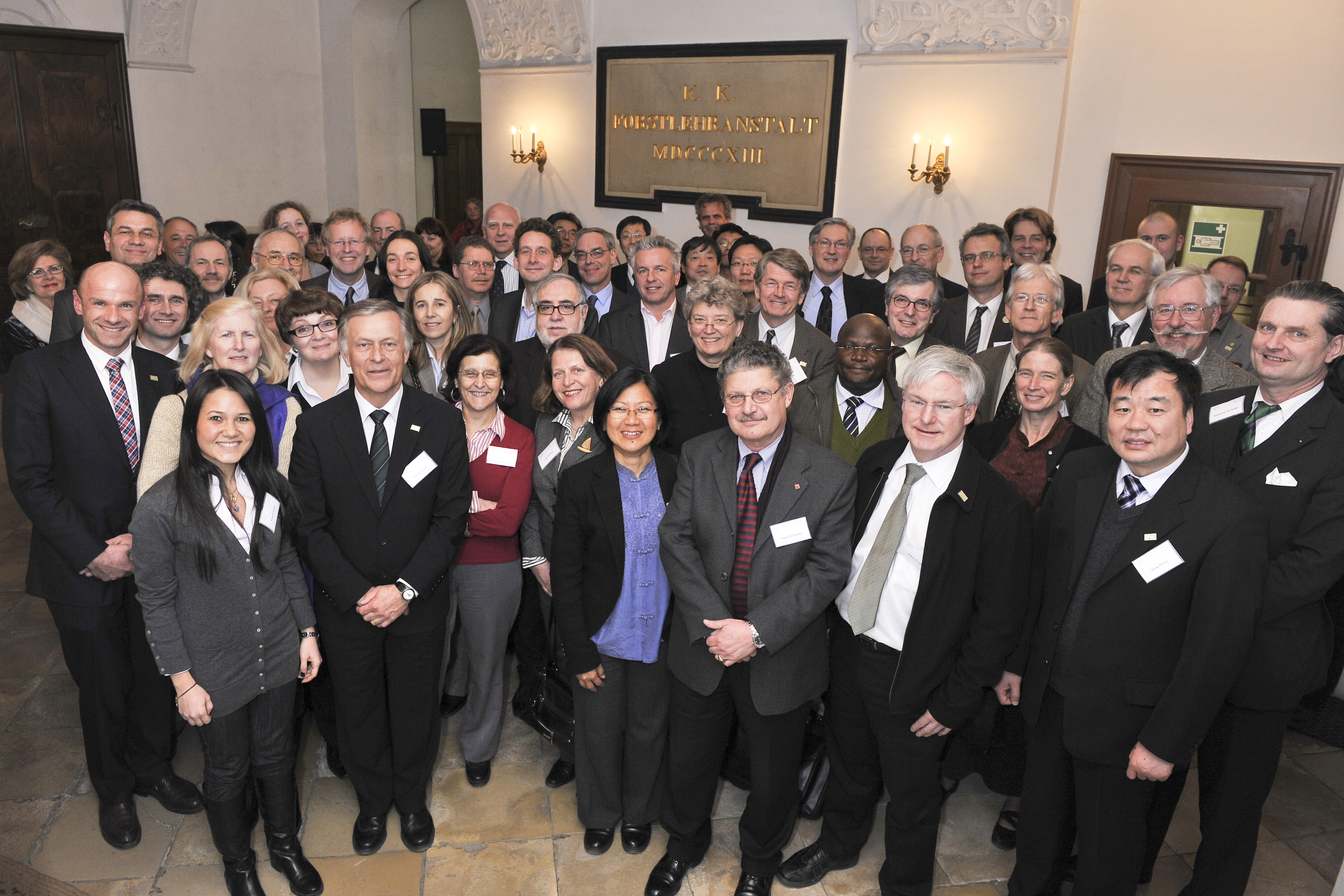Interview with Dr. Su See Lee, IUFRO Vice-President for Task Forces, Special Programmes, Projects and IUFRO-led Initiatives
Q: Dr. Lee, you are a senior scientist with the Forest Research Institute of Malaysia (FRIM) specialized in forest pathology. Why did you choose a career in forest science in the first place?
A: I have always been interested in biology and decided to specialize in botany for my first degree at the University of Malaya. That led me to my first job as a tutor at the Faculty of Forestry, Universiti Pertanian Malaysia (UPM) with the opportunity to also pursue my Masters degree at that university. UPM subsequently appointed me as a lecturer in the faculty to teach and conduct research mainly in forest pathology.
A grant from the International Foundation for Science (IFS) started me off on my first research project on dipterocarp mycorrhizas which sparked off my interest to pursue my Ph.D. at the University of Aberdeen. From then on, I was totally hooked on unraveling the many unknowns in tropical forest biology, in particular, the intricate and complicated relationships between fungi and trees. In 1990 when the chance came to take up a full-time research position at FRIM, I decided to switch from academia to full-time research and have since been enjoying conducting research into diseases of tropical forest trees, dipterocarp ectomycorrhizas, macrofungal diversity and also ethnomycology. Read more…
IUFRO Forest Governance Fact Sheet
PDF document for download
FOREST GOVERNANCE
The current set of international forest governance arrangements is best seen as a complex hybrid mix of international law, soft law, and non-governmental performance-based measures such as international certification schemes and industry codes of conduct. A diverse array of organizations and interest groups, all with different mandates, create the institutional environment for forest policy and governance. All of these actors are dedicated to supporting the different functions of forests, developing and implementing measures designed to protect the forest benefits, and interacting – often in a competitive manner – with each other for political and financial support at different levels. There are an increasing number of governance challenges, such as the demand for bioenergy and legally harvested and produced timber (e.g. EU Timber Regulation on banning illegal timber products from the EU market, to be applied in early 2013). There is clear evidence from research that complex forest problems require synergistic approaches involving a wide range of policy instruments. Read more…
Forests are a Path to Sustainable Development
13 May 2011, New York – As discussions draw to a close at the UN Commission on Sustainable Development (CSD) in UN Headquarters this week, members of the Collaborative Partnership on Forests (CPF), an international mechanism composed of 14-forest related organizations and secretariats, are calling upon countries to pay more attention to the crucial contribution of forests to sustainable development.
Members of the CPF are working to improve management, conservation and sustainable development of all types of forests. Sustainably managed forests contribute directly to poverty reduction by providing jobs, incomes, and consumable goods for poor families.
“At a time when we are faced with environmental, social, and economic crises that are daunting; the CPF is working intensively together to further catalyze the positive contributions of forests, including the livelihoods of forest-dependent people, as is being celebrated in 2011, the International Year of Forests.” says Jan McAlpine, Director of the United Nations Forum on Forests Secretariat. “Forest services and benefits are multifaceted and wide-ranging, from the environmental contributions to the social and economic. Cross-sectoral and cross-institutional cooperation and a people-relevant approach is vital not only to management of forests but for advancing sustainable development around the world.”
“Further analysis is needed during the International Year of Forests, to emphasize the connection between people and forests, and the benefits that can accrue when forests are managed by local people in sustainable and innovative ways” says Eduardo Rojas-Briales Assistant Director-General of the FAO Forestry Department. “Together we must continue to pursue multiple pathways towards sustainable development using forests at all levels.”
Rojas called attention to the 2011 edition of FAO’s State of the World’s Forests, which provides an analysis of how forests support people’s livelihoods and the development of sustainable forest industries. According to the report, forest industries are improving resource efficiency and recycling efforts and are making progress in promoting wood products as more environmentally friendly than alternative materials. Moreover, State of the World’s Forests 2011 indicates that community-based and traditional knowledge forest management approaches can help communities harvest and sell non-wood forest products to create more sustainable livelihoods.
The relevance of traditional forest-related knowledge and practices to global efforts to advance sustainable forest management, biodiversity conservation, adaptation to environmental change, and livelihood security is highlighted by a 6-year global study that has recently been completed by the International Union of Forest Research Organizations.
Emmanuel Ze Meka, Executive Director of the International Tropical Timber Organization noted that “Already in many tropical countries, sustainably managed forests and the products that arise from them are contributing to sustainable development at both the national and especially at the community level. But since sustainably managed forests still make up less than 10% of the total global tropical forest area, they clearly have the potential to play a much bigger role.”
A successful example of sustainable forest management can been seen in Guinea, where the Landscape Management for Improved Livelihoods (LAMIL) project by the World Agroforestry Centre and the Centre for International Forestry Research has had a profound influence on the sustainability of four large forest areas. Prior to the project, local people were forbidden from using the forest resources and illegal logging, poaching and land clearance were leading to forest loss. The LAMIL project developed a system of co-management involving local communities and government where the local people derive real benefits from the forests, and in return have shown their willingness and ability to manage them sustainably.
“The project illustrates how changes in how forests are governed can lead to win-win outcomes for forests and people,” commented Frances Seymour, Director General of the Center for International Forestry Research. “This project has done much to improve the welfare of the local people,” said Dennis Garrity Director General of the World Agroforestry Center. “It has also shown that sustainable forest management and improved livelihoods are inextricably linked.”
“Forests, soils and water are a trilogy that are not stand-alone, self-sustaining resources” says Luc Gnacadja, Executive Secretary of the United Nations Convention to Combat Desertification. “To foster a holistic approach to the management of these environmental resources, we must attend to three things. First, we need to focus on the causes, not the symptoms of deforestation. Second, we also need to focus on the soil, which is the real source of life for the land. Third, the communities that maintain the ecosystems we depend upon need to be rewarded.”
At the recent United Nations Forum on Forests (UNFF) meeting in February, ministers and high officials agreed on a Ministerial Declaration which stresses that “forests are an integral part of the global environment and human well-being, providing multiple goods and services essential for people worldwide and crucial for sustainable development and the achievement of the internationally agreed development goals, including the Millennium Development Goals.” The UNFF Ministerial Declaration contains the most important global forest policy issues and concerns as the concrete input on forests to the upcomingRio+20 conference. Rio+20 (June 2012), marks the twentieth anniversary of the adoption of Agenda 21, the blueprint for sustainable development, agreed upon at the 1992 United Nations Conference on Environment and Development. The conference will review progress made towards sustainable development and map out future strategies to address sustainable development and environmental challenges.
For more information:
Gerda Wolfrum, wolfrum(at)iufro.org, International Union of Forest Research Organizations (IUFRO)
World Health Day 2011: Forests Provide Untapped Resources for Human Health
Vienna/Vantaa – “It is not commonly understood how much – even in our hypermodern urban age – human health and well-being are influenced by forests and trees”, said Professor Hannu Raitio, coordinator of the IUFRO Task Force on Forests and Human Health of the Vienna-based International Union of Forest Research Organizations, and Director General of the Finnish Forest Research Institute Metla in Vantaa, prior to World Health Day on 7 April. Research shows that there is a huge untapped economic and health potential in forest biodiversity. “Preserving biodiversity attains an autonomous value – independent of any uses known at the present time”, said Professor Raitio.
Loss of species and decrease in biodiversity always imply a potential loss of health-related ecosystem services and genetic resources. The conservation of the earth’s biological diversity, of which a large part is found in forests, is increasingly recognized as an important goal. Preserving biodiversity is rational also from an economic point of view. As noted in FAO’s State of the World’s Forests 2011, many top-selling herbal products such as goji and echinacea are derived from forests, and the collection and trade of raw materials continues to significantly affect forest economies. Probably more than half of the most prescribed medicines – also in the Western pharmacopoeia – are based on chemical compounds found in natural organisms. “Even if the drug is produced synthetically, it is often first found in nature, or it may be a modification of some naturally occurring compound. We start to realize that every organism is a potent bioreactor with unique capabilities”, stated Professor Raitio.
Medical treasures waiting to be discovered
Currently only less than one per cent of all known plants are thoroughly analyzed for pharmaceuticals and with microbes, fungi and animals the percentage is even smaller. Only a small fraction of all existing species of organisms have been discovered and described so far. Moreover, all higher plants are hosts to one or more endophytic microbes, organisms residing in tissues between or among living plant cells. Of the estimated 500,000 plant species living on the planet, only a handful has had their endophytic microflora thoroughly studied.
“There are medical treasures waiting to be discovered in forest plants literally everywhere. For example, we recently began a study on the microflora of the root system of the common Scots Pine, Pinus sylvestris“, informed Professor Raitio: “We wanted to see what kind of chemical substances can be found in the microscopic fungi that are living symbiotically with the tree, and test them against the age-related eye disease (AREDS), which is a major cause of vision loss in people of advanced age all over the world. We thought that in a few years we may find a substance that could be of potential use, but only after a few months of research we already had our first candidate. We are now cooperating with medical doctors to develop a medicine of it.”
Traditional medicine also greatly relies on forest resources, for example in the treatment of malaria. Most of the hundreds of millions of cases of malaria each year are in sub-Saharan Africa, where it is the second highest cause of death from infectious disease. Poor communities have limited access to modern drugs, with the majority relying on traditional medicine in treating malaria. The World Agroforestry Centre recently published a guide entitled ‘Common Antimalarial Trees and Shrubs of East Africa’, which describes 22 species of trees and shrubs that are used as antimalarial treatments in East Africa by traditional medical practitioners and rural communities. “These species have great potential for further study and development as readily available alternative treatments for the curse of malaria,” said Najma Dharani, the main author of the book.
Sustainable management of forests to be key
Forests support the livelihoods of millions of people by providing food, water, fuel, protection against natural hazards etc., and offer a range of health-related goods and services, from medicinal compounds to the support of our psychological capacity and mental health. The key to preserve these ecosystem services is sustainable forest management (SFM), aiming at a balance between society’s increasing demands for forest products and benefits, and the preservation of forest health and diversity. This balance is critical to the survival of forests and the health of people depending on forests. “These people do not only include the forest-dwelling native tribes in various corners of the world, but every one of us, wherever we live, and whatever is our industrial or economic level. This is the most important message for us all on the World Health Day and in the United Nation’s International Year of Forests 2011“, said Professor Raitio.
The international group of scientists of the interdisciplinary IUFRO Task Force recently suggested taking into account human health aspects in all forest management activities systematically. This could be done through applying the Health Impact Assessment (HIA), a program which is promoted actively by the World Health Organization (WHO) and is to date mainly being used in urban planning, to forest-related issues. For this purpose, a set of forest-related human health indicators could be developed and included in public health reports in a similar way as they are often included in reports on water, energy, mining, biodiversity and agriculture.
For more information:
Gerda Wolfrum, wolfrum(at)iufro.org, International Union of Forest Research Organizations (IUFRO)
IUFRO Task Force on Forests and Human Health
##############################
The Collaborative Partnership on Forests (CPF) is a voluntary arrangement among 14 international organizations and secretariats with substantial programs on forests. The CPF’s mission is to promote the management, conservation and sustainable development of all types of forest and strengthen long term political commitment to this end.
CPF members:
– Center for International Forestry Research (CIFOR)
– Food and Agriculture Organization of the United Nations (FAO)
– International Tropical Timber Organization (ITTO)
– International Union of Forest Research Organizations (IUFRO)
– Convention of Biological Diversity (CBD Secretariat)
– Global Environment Facility (GEF Secretariat)
– United Nations Convention to Combat Desertification (UNCCD Secretariat)
– United Nations Forum on Forest (UNFF Secretariat)
– United Nations Framework Convention of Climate Change (UNFCCC Secretariat)
– United Nations Development Programme (UNDP)
– United Nations Environment Programme (UNEP)
– World Agroforestry Centre (ICRAF)
– World Bank (World Bank)
– The International Union for Conservation of Nature (IUCN)
IUFRO Board Appoints Michael Kleine as New Deputy Executive Director
At its 50th meeting on 23 February 2011 in Vienna, Austria, the IUFRO Board unanimously approved of Dr. Michael Kleine’s nomination as new IUFRO Deputy Executive Director. In the following interview Dr. Kleine will outline, among other things, the future orientation and coordination of programs, projects and initiatives.
Dr. Kleine, could you, first of all, give a brief account of your professional career?
I graduated in forestry from the University of Natural Resources and Life Sciences (BOKU), Vienna, Austria, and obtained a doctoral degree and habilitation from the same university. Over the past 25 years, my work has focused on forest management issues under conditions ranging from central Europe through seasonal Asia into perhumid South East Asia. My work included residential assignments in Pakistan and Malaysia for more than 12 years and short-term projects in many other countries in Asia. Read more…
IUFRO Board Paves the Way for Attaining Strategic Goals
From 23 to 25 February 2011, more than 50 members of the IUFRO Enlarged Board from 24 countries met in Vienna, Austria, for the 50th IUFRO Board Meeting. This was the first gathering of the new Board that had been elected at the XXIII World Congress in Seoul, Korea, in August 2010, for the period 2010-2014.
The Board welcomed and approved those new members and officeholders that have decided to join IUFRO’s global network, and approved the establishment of various new Research Groups and Working Parties. It appointed IUFRO-SPDC Coordinator Michael Kleine as new Deputy Executive Director and welcomed Jan Heino as IUFRO’s new Development Officer.
The one-day business meeting was followed by a two-day scientific seminar in the nearby Vienna Woods to discuss how the six key research goals of IUFRO and, consequently, the three institutional goals formulated in the IUFRO Strategy 2010-2014 could be attained.
For this purpose, the IUFRO Enlarged Board members concentrated on preparing a roadmap for new Task Forces that would be dealing with the six research goals. Together with the proposed Task Force Coordinators – each of them internationally recognized experts in their respective fields – they identified those thematic areas to which the new interdisciplinary Task Forces can add the most value to both the scientific discourse and policy deliberations. For each theme they also discussed specific entry points for the nine Divisions. The Task Forces will not generate new research but assess and synthesize existing knowledge and identify knowledge gaps. They should not duplicate work that is already underway by other institutions. Forest governance as a cross-cutting issue should be addressed by all Task Forces.
IUFRO key research goals (Task Force Coordinators/Deputies):
Forests for People (Ulrike Pröbstl, BOKU/Perry Brown, University of Montana)
Forests and Climate Change (Frances Seymour, CIFOR/Markku Kanninen, University of Helsinki)
Forest Bioenergy (Rolf Björheden, Skogforsk/Elspeth McRae, Scion)
Forest Biodiversity Conservation (Bryan Finegan, CATIE/Saw Leng Guan, FRIM)
Forest and Water Interactions (Tony Simons, ICRAF/Shirong Liu, Chinese Academy of Forestry)
Resources for the Future (John Innes, UBC/Jung-Hwan Park, KFRI)
As part of the overall roadmap agreed at the seminar, each Task Force will define cross-disciplinary activities and expected outputs and enter them into a realistic time schedule considering the resources that might be needed and identifying potential Task Force members. The Task Force Coordinators were asked to present respective Terms of Reference by early April 2011. Results of the work shall be presented prominently, among a series of other occasions, at the XXIV IUFRO World Congress in autumn 2014 in Salt Lake City, USA.
IUFRO President Niels Elers Koch commented the process confidently, “In the past IUFRO sometimes failed to start Task Forces in the right way. It was often difficult to mobilize the great knowledge and experience available in our Divisions for science-policy interactions. With this meeting, however, we want to capitalize properly on this knowledge and involve the Divisions from the very start. So it seems that we have put the Task Forces on track successfully.“
Embracing Complexity: Meeting the Challenges of International Forest Governance
IUFRO World Series Vol. 28, Edited by: Jeremy Rayner, Alexander Buck, Pia Katila

A new study assessing inter-national efforts to improve forest governance was issued together with a policy brief on 24 January 2011 by the Global Forest Expert Panel on International Forest Regime. It suggests among other things that global efforts have too often ignored local needs and failed to address the fact that deforestation is usually caused by economic pressures from outside the forests. The detailed results of the work of the expert panel, which was constituted under the Collaborative Partnership on Forests and coordinated by IUFRO, was presented to the Ninth Session of the United Nations Forum on Forests (UNFF) on 31 January 2011 as part of the launch of the International Year of Forests.
The report, the policy brief and a press release – New Study Suggests Global Pacts Like REDD Ignore Primary Causes of Destruction of Forests – are available for download.
Report and Policy Brief (English/French/Spanish): http://www.iufro.org/science/gfep/forest-regime-panel/report/
Press Release: http://www.iufro.org/science/gfep/media-information/gfep-ifr-assessment-press-release/
For more information about the Expert Panel on International Forest regime, please visit:
http://www.iufro.org/science/gfep/forest-regime-panel/





